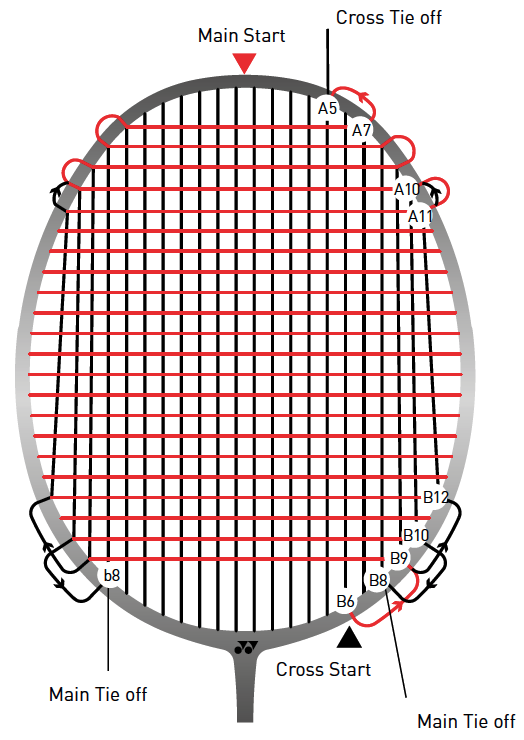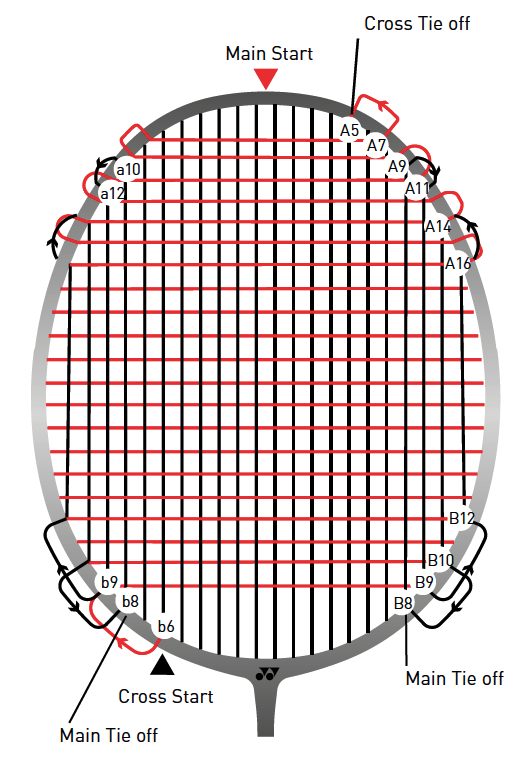Restringing a badminton racket can seem tricky, but it’s manageable. With the right steps, your racket will feel brand new again.
Badminton enthusiasts know the importance of a well-strung racket. Over time, the strings lose tension, affecting your game. Knowing how to restring your racket can save you time and money. Plus, it ensures your racket performs at its best. In this guide, we’ll walk you through the process step-by-step.
You’ll learn the tools needed and the techniques to use. By the end, you’ll be confident in restringing your racket yourself. Let’s get started on making your racket match-ready!

Credit: www.badmintonbay.com
Choosing The Right String
Selecting the right string for your badminton racket is crucial. It affects your game performance. The right string can enhance your control, power, and feel. Let’s dive into the key aspects to consider when choosing the right string.
Types Of Strings
There are several types of badminton strings. Each type offers different benefits:
- Natural Gut: Offers excellent feel and power. It is expensive and less durable.
- Synthetic Gut: Made of nylon. Offers a balance of playability and durability.
- Multifilament: Consists of many filaments. Provides a soft feel and good power.
- Polyester: Known for durability. Offers less power but good control.
String Thickness
String thickness, or gauge, is another important factor. It affects the durability and playability of the string.
| Gauge (mm) | Durability | Playability |
|---|---|---|
| 0.65-0.69 | Less durable | More playability |
| 0.70-0.75 | More durable | Less playability |
A thicker string lasts longer but may reduce your feel and control. A thinner string offers better performance but may break easily.
Consider these factors carefully. They can greatly influence your gameplay. Choose the string that aligns with your playing style and needs.
Preparing Your Racket
Preparing your racket is an essential step in restringing a badminton racket. It ensures your racket is in the best condition for new strings. This process involves removing the old strings and cleaning the frame. Both steps are crucial for a successful restringing experience.
Removing Old Strings
First, cut the old strings from your racket. Use a pair of sharp scissors or string cutters. Cut the strings in the middle of the racket. This releases tension evenly. Avoid cutting near the frame to prevent damage. Once the strings are cut, remove them carefully. Pull out any remaining pieces from the grommets. Ensure no string fragments are left behind.
Cleaning The Frame
Next, clean the frame of your racket. Use a soft cloth to wipe the entire surface. Remove any dust and debris. For stubborn dirt, use a mild soap solution. Dampen the cloth with the solution and gently clean the frame. Pay special attention to the grommets. Ensure they are free from old string bits and dirt. A clean frame helps new strings last longer.
Setting Up The Stringing Machine
Setting up the stringing machine is the first step in restringing a badminton racket. This process ensures that your racket is securely held and the tension is adjusted correctly for optimal performance. Let’s break down each step to make it easy and straightforward.
Mounting The Racket
First, place your racket on the machine’s mounting system. Ensure the frame is centered and secure. Check that the racket’s head and throat are firmly held. This prevents any movement during the stringing process. Double-check all clamps and supports. A stable racket frame is crucial for accurate stringing.
Adjusting Tension Settings
Next, adjust the tension settings on the machine. Different players prefer different string tensions. Refer to your racket’s recommended tension range. Set the machine to your desired tension level. Ensure the tension is consistent throughout the stringing process. Proper tension enhances your game performance and racket durability.
Stringing The Mains
Stringing the mains of a badminton racket can seem challenging. But with the right steps, you can do it. This section will guide you through the process. You’ll learn how to start the first main string and weave it through the grommets.
Starting The First Main String
Begin by securing the racket in the stringing machine. Make sure it’s held tightly. Then, cut the string to the correct length. Insert one end of the string into the center grommet at the top of the racket. Pull the string through until both sides are equal in length.
Weaving Through The Grommets
Next, weave the string through the grommets. Start from the center and move outward. Push the string through the holes on the racket frame. Pull it tight with each pass. Ensure there are no twists or knots. Repeat the process for each main string. Continue until all the main strings are properly woven.
Stringing The Crosses
Stringing the crosses in your badminton racket is crucial for optimal performance. This step ensures the strings are tight and even. It affects the racket’s power and control. Follow these steps to string the crosses correctly.
Starting The First Cross String
Begin at the top of the racket. Secure the string through the first grommet hole. Pull the string tightly to avoid slack. Use a clamp to hold it in place. Move to the next hole and repeat the process. Ensure each string is parallel to the main strings.
Maintaining Tension
Keeping tension consistent is key. Use a tensioner to maintain even pressure. Move the string through each grommet hole with care. Avoid pulling too hard or too soft. Check tension regularly. Adjust as needed to ensure uniform tension.

Credit: www.ifixit.com
Tying Off The Strings
Restringing a badminton racket involves several steps. One of the crucial steps is tying off the strings. Properly securing the strings ensures they stay in place during intense gameplay. In this section, we will delve into the details of securing the knots and trimming the excess string.
Securing The Knots
To secure the knots, follow these steps:
- Double knot: Start by creating a double knot. This helps in keeping the string tight and secure.
- Use a needle: Insert the end of the string into a needle. This makes it easier to thread through the small holes in the racket.
- Pull tightly: Ensure the knot is tight by pulling both ends of the string. This prevents the string from loosening during play.
- Check for firmness: Press on the strings to ensure they are firm and secure. A loose string can affect your game.
Trimming Excess String
Once the knots are secure, trimming the excess string is essential. Follow these simple steps:
- Sharp scissors: Use a sharp pair of scissors to cut the excess string. A clean cut ensures the string does not fray.
- Leave a small tail: Leave a small tail of about 1-2 cm. This provides extra security to the knot.
- Inspect the racket: Check the entire racket to ensure no excess string is left hanging. This keeps your racket neat and ready for the game.
By following these steps, you can ensure your badminton racket is properly strung and ready for optimal performance on the court.
Post-stringing Checks
After restringing your badminton racket, it is vital to perform post-stringing checks. These checks ensure that your racket is in top shape and ready for play. Two important checks are tension consistency and damage inspection.
Checking Tension Consistency
First, examine the tension of the strings. This ensures uniform tension across the racket. Follow these steps:
- Press the strings with your thumb.
- Move your thumb from the center to the edges.
- Feel for any uneven tension or loose strings.
Inconsistent tension affects control and power. Correcting this is crucial for performance.
Inspecting For Damage
Next, inspect the racket for any potential damage. Follow these steps:
- Check the frame for cracks or dents.
- Examine the grommets for wear or breakage.
- Inspect the strings for fraying or splits.
Damage to the racket can impact its durability and performance. Addressing any issues ensures a long-lasting racket.
By performing these post-stringing checks, you maintain your racket’s condition. You also ensure optimal performance during your games.
Maintenance Tips
Maintaining your badminton racket is crucial for optimal performance. Proper care ensures your racket lasts longer and performs better. Follow these maintenance tips to keep your equipment in top shape.
Regular Inspections
Inspect your racket regularly. Look for signs of wear and tear. Check the strings for fraying or damage. Ensure the frame is intact without cracks. A regular inspection can help you identify issues early. This prevents bigger problems later.
Optimal Storage Conditions
Store your racket in a cool, dry place. Avoid extreme temperatures. Excessive heat can damage the strings and frame. Moisture can cause the strings to lose tension. Use a racket cover for extra protection.
Here are some optimal storage tips:
- Use a protective cover to shield your racket from dust and dirt.
- Keep away from direct sunlight which can weaken the racket’s material.
- Avoid damp areas to prevent mold or mildew on the grip.
Proper storage extends the life of your badminton racket. It ensures your equipment stays in top condition for every match.

Credit: www.youtube.com
Frequently Asked Questions
How Often Should I Restring My Badminton Racket?
It depends on usage frequency. Regular players should restring every 3 months. Occasional players can restring every 6 months.
What String Tension Is Ideal For Beginners?
Beginners should opt for a lower tension, around 18-22 lbs. This provides better control and comfort.
Can I Restring My Racket At Home?
Yes, you can. You’ll need a stringing machine and some practice. It may take time to master.
How Do I Choose The Right String?
Consider your playing style and skill level. Beginners should choose durable strings. Advanced players might prefer thinner, high-performance strings.
Conclusion
Restringing a badminton racket can boost your game. Follow these easy steps. Practice makes perfect. Make sure to check the tension regularly. It ensures better performance. Don’t rush through the process. Take your time. The right string tension can improve your shots.
Pay attention to details. Your racket will thank you. Enjoy playing with a freshly strung racket!



